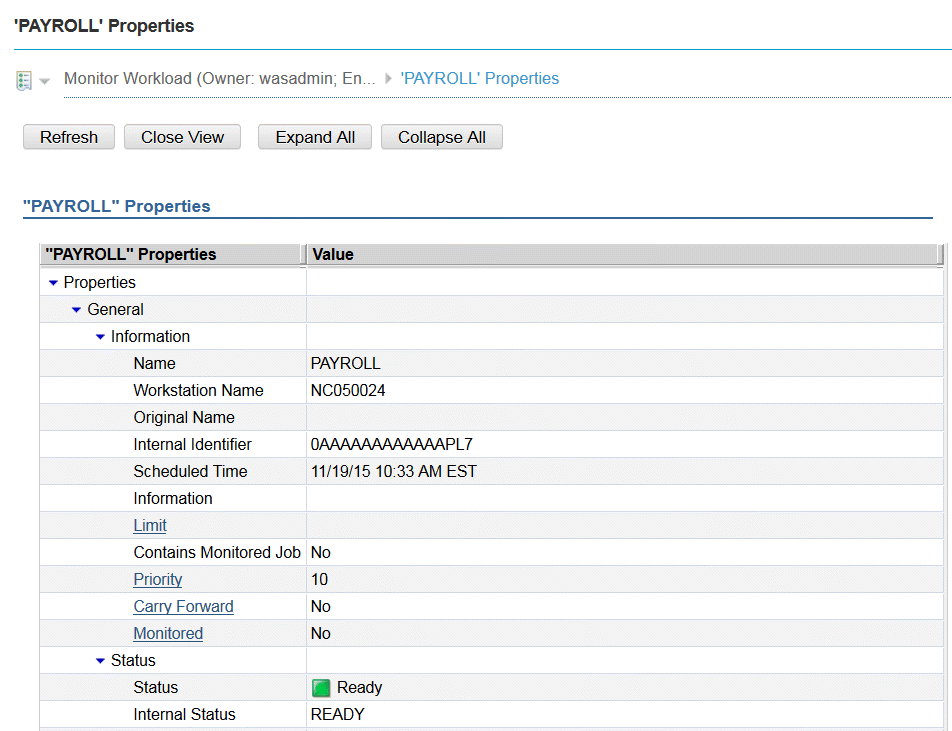Monitoring conditional dependencies
Monitor HCL Workload Automation jobs by using the Dynamic Workload Console or the conman command line.

You can monitor output conditions using the conman showjobs and showschedules command line.
%ss @#PAYROLL
(Est) (Est) Jobs Sch
Workstation Job Stream SchedTime State Pr Start Elapse # OK Lim
NC050024 #PAYROLL 0958 11/19 HOLD 10 7 0
%sj @#PAYROLL
(Est) (Est)
Workstation Job Stream SchedTime Job State Pr Start Elapse ReturnCode Dependencies
NC050024 #PAYROLL 0958 11/19 ************************** READY 10
(NC050024_1_1#)OPERATOR_INTERVENTION HOLD 10 ABSENCES IF UNKNOWN_ERR
(NC050024_1_1#)DB_BACKUP HOLD 10 JOIN SUCCESS 1 OF
ABSENCES IF SUCC
ABSENCES_RETRY IF SUCC
(NC050024_1_1#)ABSENCES READY 10
(NC050024_1_1#)RESTART_DB HOLD 10 ABSENCES IF DB_FAIL
(NC050024_1_1#)RESTART_WAS HOLD 10 ABSENCES IF WAS_FAIL
(NC050024_1_1#)TEMP_CLEANUP HOLD 10 ABSENCES IF TEMP_FULL
(NC050024_1_1#)ABSENCES_RETRY HOLD 10 JOIN PROBLEM_SOLVING 1 OF
RESTART_DB
RESTART_WAS
TEMP_CLEANUP%sj NC050024#PAYROLL.ABSENCES;info
-------- Restart ---------
Workstation Job Stream SchedTime Job JobFile Opt Job Prompt
NC050024 #PAYROLL 0958 11/19
(NC050024_1_1#)ABSENCES
....... oc: DB_FAIL n/a "RC=1"
oc: TEMP_FULL n/a "RC=3"
oc: UNKNOWN_ERR n/a "RC>3"
oc: WAS_FAIL n/a "RC=2"%sj NC050024#PAYROLL.ABSENCES;props
General Information
Job = ABSENCES
Workstation = NC050024_1_1
.....
Other Output Conditions
DB_FAIL = n/a "RC=1"
TEMP_FULL = n/a "RC=3"
UNKNOWN_ERR = n/a "RC>3"
WAS_FAIL = n/a "RC=2"
........Monitoring join conditional dependencies

Join dependencies are represented using composer-like syntax. Only unresolved and undecided join dependencies are displayed. If the join dependency is satisfied, no dependencies are displayed.
%sj @#PAYROLL
(Est) (Est)
Workstation Job Stream SchedTime Job State Pr Start Elapse ReturnCode Dependencies
NC050024 #PAYROLL 1007 11/19 **************************************** READY 10 10:08 (00:01)
(NC050024_1_1#)OPERATOR_INTERVENTION SUPPR 10 ABSENCES IF UNKNOWN_ERR
(NC050024_1_1#)DB_BACKUP HOLD 10 (00:01) JOIN SUCCESS 1 OF
ABSENCES IF SUCC
ABSENCES_RETRY IF SUCC
(NC050024_1_1#)ABSENCES ABEND 10 10:08 00:01 1 #J355305499
(NC050024_1_1#)RESTART_DB SUCC 10 10:08 00:01 0 #J355305500
(NC050024_1_1#)RESTART_WAS SUPPR 10 ABSENCES IF WAS_FAIL
(NC050024_1_1#)TEMP_CLEANUP SUPPR 10 ABSENCES IF TEMP_FULL
(NC050024_1_1#)ABSENCES_RETRY SUCC 10 10:09 00:01 0 #J355305501%sj @#PAYROLL
(Est) (Est)
Workstation Job Stream SchedTime Job State Pr Start Elapse ReturnCode Dependencies
NC050024 #PAYROLL 1007 11/19 **************************************** ABEND 10 10:08 00:02
(NC050024_1_1#)OPERATOR_INTERVENTION SUPPR 10 ABSENCES IF UNKNOWN_ERR
(NC050024_1_1#)DB_BACKUP SUCC 10 10:09 00:01 0 #J355305502
(NC050024_1_1#)ABSENCES ABEND 10 10:08 00:01 1 #J355305499
(NC050024_1_1#)RESTART_DB SUCC 10 10:08 00:01 0 #J355305500
(NC050024_1_1#)RESTART_WAS SUPPR 10 ABSENCES IF WAS_FAIL
(NC050024_1_1#)TEMP_CLEANUP SUPPR 10 ABSENCES IF TEMP_FULL
(NC050024_1_1#)ABSENCES_RETRY SUCC 10 10:09 00:01 0 #J355305501
Similarly, when plan replication is enabled, all dependencies of a job or job stream in suppress state are evaluated. When plan replication is not enabled, the evaluation of dependencies stops as soon as a job or job stream is put in suppress state because of a conditional dependency that was not satisfied. In both of these cases, the end result is the same, however, when monitoring the progress of the jobs and job streams in these two situations, you might see differing results.